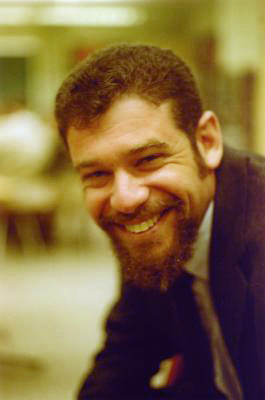
In probability and statistics, a Bernoulli process is a finite or infinite sequence of binary random variables, so it is a discrete-time stochastic process that takes only two values, canonically 0 and 1. The component Bernoulli variablesXi are identically distributed and independent. Prosaically, a Bernoulli process is a repeated coin flipping, possibly with an unfair coin. Every variable Xi in the sequence is associated with a Bernoulli trial or experiment. They all have the same Bernoulli distribution. Much of what can be said about the Bernoulli process can also be generalized to more than two outcomes ; this generalization is known as the Bernoulli scheme.
Ergodic theory is a branch of mathematics that studies statistical properties of deterministic dynamical systems; it is the study of ergodicity. In this context, "statistical properties" refers to properties which are expressed through the behavior of time averages of various functions along trajectories of dynamical systems. The notion of deterministic dynamical systems assumes that the equations determining the dynamics do not contain any random perturbations, noise, etc. Thus, the statistics with which we are concerned are properties of the dynamics.
In mathematics, a measure-preserving dynamical system is an object of study in the abstract formulation of dynamical systems, and ergodic theory in particular. Measure-preserving systems obey the Poincaré recurrence theorem, and are a special case of conservative systems. They provide the formal, mathematical basis for a broad range of physical systems, and, in particular, many systems from classical mechanics as well as systems in thermodynamic equilibrium.
A Hamiltonian system is a dynamical system governed by Hamilton's equations. In physics, this dynamical system describes the evolution of a physical system such as a planetary system or an electron in an electromagnetic field. These systems can be studied in both Hamiltonian mechanics and dynamical systems theory.

Yakov Grigorevich Sinai is a Russian–American mathematician known for his work on dynamical systems. He contributed to the modern metric theory of dynamical systems and connected the world of deterministic (dynamical) systems with the world of probabilistic (stochastic) systems. He has also worked on mathematical physics and probability theory. His efforts have provided the groundwork for advances in the physical sciences.
In mathematics, subshifts of finite type are used to model dynamical systems, and in particular are the objects of study in symbolic dynamics and ergodic theory. They also describe the set of all possible sequences executed by a finite state machine. The most widely studied shift spaces are the subshifts of finite type.

A dynamical billiard is a dynamical system in which a particle alternates between free motion and specular reflections from a boundary. When the particle hits the boundary it reflects from it without loss of speed. Billiards are Hamiltonian idealizations of the game of billiards, but where the region contained by the boundary can have shapes other than rectangular and even be multidimensional. Dynamical billiards may also be studied on non-Euclidean geometries; indeed, the first studies of billiards established their ergodic motion on surfaces of constant negative curvature. The study of billiards which are kept out of a region, rather than being kept in a region, is known as outer billiard theory.
In mathematics, the Bernoulli scheme or Bernoulli shift is a generalization of the Bernoulli process to more than two possible outcomes. Bernoulli schemes appear naturally in symbolic dynamics, and are thus important in the study of dynamical systems. Many important dynamical systems exhibit a repellor that is the product of the Cantor set and a smooth manifold, and the dynamics on the Cantor set are isomorphic to that of the Bernoulli shift. This is essentially the Markov partition. The term shift is in reference to the shift operator, which may be used to study Bernoulli schemes. The Ornstein isomorphism theorem shows that Bernoulli shifts are isomorphic when their entropy is equal.

In mathematics, a flow formalizes the idea of the motion of particles in a fluid. Flows are ubiquitous in science, including engineering and physics. The notion of flow is basic to the study of ordinary differential equations. Informally, a flow may be viewed as a continuous motion of points over time. More formally, a flow is a group action of the real numbers on a set.
In mathematics, ergodic flows occur in geometry, through the geodesic and horocycle flows of closed hyperbolic surfaces. Both of these examples have been understood in terms of the theory of unitary representations of locally compact groups: if Γ is the fundamental group of a closed surface, regarded as a discrete subgroup of the Möbius group G = PSL(2,R), then the geodesic and horocycle flow can be identified with the natural actions of the subgroups A of real positive diagonal matrices and N of lower unitriangular matrices on the unit tangent bundle G / Γ. The Ambrose-Kakutani theorem expresses every ergodic flow as the flow built from an invertible ergodic transformation on a measure space using a ceiling function. In the case of geodesic flow, the ergodic transformation can be understood in terms of symbolic dynamics; and in terms of the ergodic actions of Γ on the boundary S1 = G / AN and G / A = S1 × S1 \ diag S1. Ergodic flows also arise naturally as invariants in the classification of von Neumann algebras: the flow of weights for a factor of type III0 is an ergodic flow on a measure space.
In mathematics, Mostow's rigidity theorem, or strong rigidity theorem, or Mostow–Prasad rigidity theorem, essentially states that the geometry of a complete, finite-volume hyperbolic manifold of dimension greater than two is determined by the fundamental group and hence unique. The theorem was proven for closed manifolds by Mostow (1968) and extended to finite volume manifolds by Marden (1974) in 3 dimensions, and by Prasad (1973) in all dimensions at least 3. Gromov (1981) gave an alternate proof using the Gromov norm. Besson, Courtois & Gallot (1996) gave the simplest available proof.
In mathematics, ergodicity expresses the idea that a point of a moving system, either a dynamical system or a stochastic process, will eventually visit all parts of the space that the system moves in, in a uniform and random sense. This implies that the average behavior of the system can be deduced from the trajectory of a "typical" point. Equivalently, a sufficiently large collection of random samples from a process can represent the average statistical properties of the entire process. Ergodicity is a property of the system; it is a statement that the system cannot be reduced or factored into smaller components. Ergodic theory is the study of systems possessing ergodicity.

Donald Samuel Ornstein is an American mathematician working in the area of ergodic theory. He received a Ph.D. from the University of Chicago in 1957 under the guidance of Irving Kaplansky. During his career at Stanford University he supervised the Ph. D. thesis of twenty three students, including David H. Bailey, Bob Burton, Doug Lind, Ami Radunskaya, Dan Rudolph, and Jeff Steif.
Lehmer's conjecture, also known as the Lehmer's Mahler measure problem, is a problem in number theory raised by Derrick Henry Lehmer. The conjecture asserts that there is an absolute constant such that every polynomial with integer coefficients satisfies one of the following properties:
In mathematics, topological dynamics is a branch of the theory of dynamical systems in which qualitative, asymptotic properties of dynamical systems are studied from the viewpoint of general topology.
In mathematics, a Kolmogorov automorphism, K-automorphism, K-shift or K-system is an invertible, measure-preserving automorphism defined on a standard probability space that obeys Kolmogorov's zero–one law. All Bernoulli automorphisms are K-automorphisms, but not vice versa. Many ergodic dynamical systems have been shown to have the K-property, although more recent research has shown that many of these are in fact Bernoulli automorphisms.

Anatoly Borisovich Katok was an American mathematician with Russian-Jewish origins. Katok was the director of the Center for Dynamics and Geometry at the Pennsylvania State University. His field of research was the theory of dynamical systems.
In mathematics, the Rokhlin lemma, or Kakutani–Rokhlin lemma is an important result in ergodic theory. It states that an aperiodic measure preserving dynamical system can be decomposed to an arbitrary high tower of measurable sets and a remainder of arbitrarily small measure. It was proven by Vladimir Abramovich Rokhlin and independently by Shizuo Kakutani. The lemma is used extensively in ergodic theory, for example in Ornstein theory and has many generalizations.

Yakov Borisovich Pesin was born in Moscow, Russia on December 12, 1946. Pesin is currently a Distinguished Professor in the Department of Mathematics and the Director of the Anatole Katok Center for Dynamical Systems and Geometry at the Pennsylvania State University (PSU). His primary areas of research are the theory of dynamical systems with an emphasis on smooth ergodic theory, dimension theory in dynamical systems, and Riemannian geometry, as well as mathematical and statistical physics.
In the mathematical discipline of ergodic theory, a Sinai–Ruelle–Bowen (SRB) measure is an invariant measure that behaves similarly to, but is not an ergodic measure. In order to be ergodic, the time average would need to be equal the space average for almost all initial states , with being the phase space. For an SRB measure , it suffices that the ergodicity condition be valid for initial states in a set of positive Lebesgue measure.












